Entry Database : PDB / ID : 1xv9Title crystal structure of CAR/RXR heterodimer bound with SRC1 peptide, fatty acid, and 5b-pregnane-3,20-dione. Orphan nuclear receptor NR1I3 Retinoic acid receptor RXR-alpha nuclear receptor coactivator 1 isoform 1 Keywords / / / / Function / homology Function Domain/homology Component
/ / / / / / / / / / / / / / / / / / / / / / / / / / / / / / / / / / / / / / / / / / / / / / / / / / / / / / / / / / / / / / / / / / / / / / / / / / / / / / / / / / / / / / / / / / / / / / / / / / / / / / / / / / / / / / / / / / / / / / / / / / / / / / / / / / / / / / / / / / / / / / / / / / / / / / / / / / / / / / / / / / / / Biological species Homo sapiens (human)Method / / / Resolution : 2.7 Å Authors Xu, R.X. / Lambert, M.H. / Wisely, B.B. / Warren, E.N. / Weinert, E.E. / Waitt, G.M. / Williams, J.D. / Moore, L.B. / Willson, T.M. / Moore, J.T. Journal : Mol.Cell / Year : 2004Title : A Structural Basis for Constitutive Activity in the Human CAR/RXRalpha Heterodimer.Authors : Xu, R.X. / Lambert, M.H. / Wisely, B.B. / Warren, E.N. / Weinert, E.E. / Waitt, G.M. / Williams, J.D. / Collins, J.L. / Moore, L.B. / Willson, T.M. / Moore, J.T. History Deposition Oct 27, 2004 Deposition site / Processing site Revision 1.0 Dec 28, 2004 Provider / Type Revision 1.1 Apr 30, 2008 Group Revision 1.2 Jul 13, 2011 Group Revision 1.3 Nov 30, 2016 Group / Source and taxonomyRevision 1.4 Feb 14, 2024 Group / Database references / Derived calculationsCategory chem_comp_atom / chem_comp_bond ... chem_comp_atom / chem_comp_bond / database_2 / struct_ref_seq_dif / struct_site Item _database_2.pdbx_DOI / _database_2.pdbx_database_accession ... _database_2.pdbx_DOI / _database_2.pdbx_database_accession / _struct_ref_seq_dif.details / _struct_site.pdbx_auth_asym_id / _struct_site.pdbx_auth_comp_id / _struct_site.pdbx_auth_seq_id
Show all Show less
 Yorodumi
Yorodumi Open data
Open data Basic information
Basic information Components
Components Keywords
Keywords DNA BINDING PROTEIN /
DNA BINDING PROTEIN /  CAR / RXR /
CAR / RXR /  SRC1 / pregnanedione
SRC1 / pregnanedione Function and homology information
Function and homology information ion binding ...positive regulation of transporter activity / retinoic acid-responsive element binding / NR1H2 & NR1H3 regulate gene expression linked to gluconeogenesis / NR1H2 & NR1H3 regulate gene expression linked to triglyceride lipolysis in adipose / NR1H2 & NR1H3 regulate gene expression to limit cholesterol uptake / positive regulation of thyroid hormone mediated signaling pathway / NR1H2 & NR1H3 regulate gene expression linked to lipogenesis / Carnitine metabolism / anatomical structure development /
ion binding ...positive regulation of transporter activity / retinoic acid-responsive element binding / NR1H2 & NR1H3 regulate gene expression linked to gluconeogenesis / NR1H2 & NR1H3 regulate gene expression linked to triglyceride lipolysis in adipose / NR1H2 & NR1H3 regulate gene expression to limit cholesterol uptake / positive regulation of thyroid hormone mediated signaling pathway / NR1H2 & NR1H3 regulate gene expression linked to lipogenesis / Carnitine metabolism / anatomical structure development /  ion binding / Regulation of pyruvate dehydrogenase (PDH) complex /
ion binding / Regulation of pyruvate dehydrogenase (PDH) complex /  retinoic acid binding / labyrinthine layer morphogenesis / regulation of thyroid hormone mediated signaling pathway / positive regulation of transcription from RNA polymerase II promoter by galactose / positive regulation of vitamin D receptor signaling pathway / nuclear vitamin D receptor binding / positive regulation of female receptivity / Signaling by Retinoic Acid / hypothalamus development /
retinoic acid binding / labyrinthine layer morphogenesis / regulation of thyroid hormone mediated signaling pathway / positive regulation of transcription from RNA polymerase II promoter by galactose / positive regulation of vitamin D receptor signaling pathway / nuclear vitamin D receptor binding / positive regulation of female receptivity / Signaling by Retinoic Acid / hypothalamus development /  DNA binding domain binding / nuclear steroid receptor activity / male mating behavior / NR1H2 & NR1H3 regulate gene expression to control bile acid homeostasis / LBD domain binding /
DNA binding domain binding / nuclear steroid receptor activity / male mating behavior / NR1H2 & NR1H3 regulate gene expression to control bile acid homeostasis / LBD domain binding /  estrous cycle / positive regulation of cholesterol efflux / cellular response to Thyroglobulin triiodothyronine / Synthesis of bile acids and bile salts / retinoic acid receptor signaling pathway / Endogenous sterols / Synthesis of bile acids and bile salts via 27-hydroxycholesterol / positive regulation of bone mineralization / Synthesis of bile acids and bile salts via 7alpha-hydroxycholesterol / nuclear retinoid X receptor binding / NR1H3 & NR1H2 regulate gene expression linked to cholesterol transport and efflux / response to retinoic acid /
estrous cycle / positive regulation of cholesterol efflux / cellular response to Thyroglobulin triiodothyronine / Synthesis of bile acids and bile salts / retinoic acid receptor signaling pathway / Endogenous sterols / Synthesis of bile acids and bile salts via 27-hydroxycholesterol / positive regulation of bone mineralization / Synthesis of bile acids and bile salts via 7alpha-hydroxycholesterol / nuclear retinoid X receptor binding / NR1H3 & NR1H2 regulate gene expression linked to cholesterol transport and efflux / response to retinoic acid /  histone acetyltransferase activity / Recycling of bile acids and salts / regulation of cellular response to insulin stimulus /
histone acetyltransferase activity / Recycling of bile acids and salts / regulation of cellular response to insulin stimulus /  histone acetyltransferase / cellular response to hormone stimulus / positive regulation of adipose tissue development / peroxisome proliferator activated receptor signaling pathway / RORA activates gene expression / positive regulation of neuron differentiation /
histone acetyltransferase / cellular response to hormone stimulus / positive regulation of adipose tissue development / peroxisome proliferator activated receptor signaling pathway / RORA activates gene expression / positive regulation of neuron differentiation /  lactation / Regulation of lipid metabolism by PPARalpha / cerebellum development / hormone-mediated signaling pathway / BMAL1:CLOCK,NPAS2 activates circadian gene expression / nuclear receptor coactivator activity / SUMOylation of transcription cofactors / Activation of gene expression by SREBF (SREBP) / response to progesterone / nuclear estrogen receptor binding /
lactation / Regulation of lipid metabolism by PPARalpha / cerebellum development / hormone-mediated signaling pathway / BMAL1:CLOCK,NPAS2 activates circadian gene expression / nuclear receptor coactivator activity / SUMOylation of transcription cofactors / Activation of gene expression by SREBF (SREBP) / response to progesterone / nuclear estrogen receptor binding /  transcription coregulator binding /
transcription coregulator binding /  nuclear receptor binding / hippocampus development / RNA polymerase II transcription regulatory region sequence-specific DNA binding /
nuclear receptor binding / hippocampus development / RNA polymerase II transcription regulatory region sequence-specific DNA binding /  peptide binding / Heme signaling / SUMOylation of intracellular receptors / mRNA transcription by RNA polymerase II / Transcriptional activation of mitochondrial biogenesis / PPARA activates gene expression / Cytoprotection by HMOX1 / cerebral cortex development / osteoblast differentiation / Transcriptional regulation of white adipocyte differentiation / Activation of anterior HOX genes in hindbrain development during early embryogenesis / Nuclear Receptor transcription pathway / Transcriptional regulation of granulopoiesis / RNA polymerase II transcription regulator complex / male gonad development /
peptide binding / Heme signaling / SUMOylation of intracellular receptors / mRNA transcription by RNA polymerase II / Transcriptional activation of mitochondrial biogenesis / PPARA activates gene expression / Cytoprotection by HMOX1 / cerebral cortex development / osteoblast differentiation / Transcriptional regulation of white adipocyte differentiation / Activation of anterior HOX genes in hindbrain development during early embryogenesis / Nuclear Receptor transcription pathway / Transcriptional regulation of granulopoiesis / RNA polymerase II transcription regulator complex / male gonad development /  nuclear receptor activity /
nuclear receptor activity /  Circadian Clock / sequence-specific double-stranded DNA binding / response to estradiol / HATs acetylate histones /
Circadian Clock / sequence-specific double-stranded DNA binding / response to estradiol / HATs acetylate histones /  double-stranded DNA binding / DNA-binding transcription activator activity, RNA polymerase II-specific / Estrogen-dependent gene expression /
double-stranded DNA binding / DNA-binding transcription activator activity, RNA polymerase II-specific / Estrogen-dependent gene expression /  transcription regulator complex / sequence-specific DNA binding /
transcription regulator complex / sequence-specific DNA binding /  cell differentiation /
cell differentiation /  transcription coactivator activity /
transcription coactivator activity /  protein dimerization activity /
protein dimerization activity /  cytoskeleton /
cytoskeleton /  receptor complex / transcription cis-regulatory region binding / DNA-binding transcription factor activity, RNA polymerase II-specific / positive regulation of apoptotic process / RNA polymerase II cis-regulatory region sequence-specific DNA binding / DNA-binding transcription factor activity /
receptor complex / transcription cis-regulatory region binding / DNA-binding transcription factor activity, RNA polymerase II-specific / positive regulation of apoptotic process / RNA polymerase II cis-regulatory region sequence-specific DNA binding / DNA-binding transcription factor activity /  chromatin binding /
chromatin binding /  chromatin / positive regulation of DNA-templated transcription / negative regulation of transcription by RNA polymerase II /
chromatin / positive regulation of DNA-templated transcription / negative regulation of transcription by RNA polymerase II /  enzyme binding
enzyme binding
 Homo sapiens (human)
Homo sapiens (human) X-RAY DIFFRACTION /
X-RAY DIFFRACTION /  SYNCHROTRON /
SYNCHROTRON /  MOLECULAR REPLACEMENT / Resolution: 2.7 Å
MOLECULAR REPLACEMENT / Resolution: 2.7 Å  Authors
Authors Citation
Citation Journal: Mol.Cell / Year: 2004
Journal: Mol.Cell / Year: 2004 Structure visualization
Structure visualization Molmil
Molmil Jmol/JSmol
Jmol/JSmol Downloads & links
Downloads & links Download
Download 1xv9.cif.gz
1xv9.cif.gz PDBx/mmCIF format
PDBx/mmCIF format pdb1xv9.ent.gz
pdb1xv9.ent.gz PDB format
PDB format 1xv9.json.gz
1xv9.json.gz PDBx/mmJSON format
PDBx/mmJSON format Other downloads
Other downloads https://data.pdbj.org/pub/pdb/validation_reports/xv/1xv9
https://data.pdbj.org/pub/pdb/validation_reports/xv/1xv9 ftp://data.pdbj.org/pub/pdb/validation_reports/xv/1xv9
ftp://data.pdbj.org/pub/pdb/validation_reports/xv/1xv9 Links
Links Assembly
Assembly
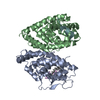
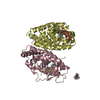
 Components
Components
 Homo sapiens (human) / Gene: RXRA, NR2B1 / Production host:
Homo sapiens (human) / Gene: RXRA, NR2B1 / Production host: 
 Escherichia coli (E. coli) / References: UniProt: P19793
Escherichia coli (E. coli) / References: UniProt: P19793
 Homo sapiens (human) / Production host:
Homo sapiens (human) / Production host: 
 Escherichia coli (E. coli) / References: UniProt: Q14994
Escherichia coli (E. coli) / References: UniProt: Q14994
 Homo sapiens (human) / References: GenBank: 22538455, UniProt: Q15788*PLUS
Homo sapiens (human) / References: GenBank: 22538455, UniProt: Q15788*PLUS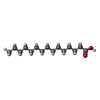
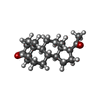



 Pentadecylic acid
Pentadecylic acid Water
Water X-RAY DIFFRACTION / Number of used crystals: 1
X-RAY DIFFRACTION / Number of used crystals: 1  Sample preparation
Sample preparation
 SYNCHROTRON / Site:
SYNCHROTRON / Site:  APS
APS  / Beamline: 17-ID / Wavelength: 1 Å
/ Beamline: 17-ID / Wavelength: 1 Å : 1 Å / Relative weight: 1
: 1 Å / Relative weight: 1  Processing
Processing :
:  MOLECULAR REPLACEMENT / Resolution: 2.7→50 Å / σ(F): 0 / σ(I): 0 / Stereochemistry target values: Engh & Huber
MOLECULAR REPLACEMENT / Resolution: 2.7→50 Å / σ(F): 0 / σ(I): 0 / Stereochemistry target values: Engh & Huber Movie
Movie Controller
Controller





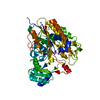

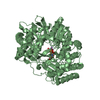
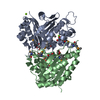
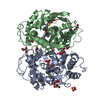
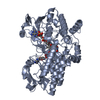
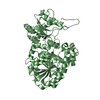
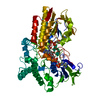
 PDBj
PDBj













